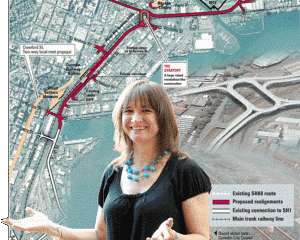Transport officials have highlighted a dramatic reduction in the cost-efficiency of the Government's multibillion-dollar spend-up on new highways.
But Transport Minister Gerry Brownlee says he is not concerned about what he expects will turn out to be only a short-term movement, and insists the Government is on track to keep the country moving.
Labour's transport spokesman, Phil Twyford, has pointed to a graph in a Ministry of Transport briefing paper as evidence of "poor-quality spending'' on highways led by the Government's Roads of National Significance programme.
But Mr Brownlee told the Herald that Mr Twyford was wrong calling changes over a mere two years a trend, and said he was satisfied highway projects planned for Auckland would produce great benefits both for the region and the national economy.
According to the graph, prepared by officials for their incoming minister, approved highway projects expected to yield high economic returns dwindled below 10 per cent in 2009-10 compared with more than 75 per cent two years earlier.
More than 60 per cent were accorded low cost-benefit ratios and about 30 per cent were expected to provide only medium-level returns on investment.
Asked by Mr Twyford in Parliament whether he was concerned by the trend since Labour was last in power in 2008, the minister said he was not.
Mr Brownlee asked why Labour leader David Shearer did not support Auckland's western ring route, which includes the $2 billion Waterview project running through that MP's Mt Albert electorate, when it had "a very good cost-benefit ratio''.
The Transport Agency predicts a return from the 48km ring route between Manukau and Albany of $2.70 for each $1 invested, although that includes what are termed wider economic benefits as well as narrow transport gains such as from fuel and time savings.
But the return from the proposed new replacement $1.65 billion highway between Puhoi and Wellsford -which is delayed because difficult geological conditions are complicating a final route selection - is calculated at just $1.10 for each $1 invested.
Mr Twyford said National had "corrupted'' the process of setting priorities in transport funding by hand-picking the seven "so-called Roads of National Significance''.
"In the process they have squeezed funding for local roads, rural roads and public transport,'' he said.
"Cash-starved rural roads are being torn apart by logging trucks and milk tankers and National is blocking Auckland's plan for the [tunnelled] City Rail Link, which would double the capacity of the city's rail network.''
Mr Brownlee said measured economic efficiency was only one element in planning transport projects. "We're talking about networks and changing the way traffic flows around Auckland.
"I'm not concerned about those graphs at this point _ I don't think they indicate a worrying trend at all.''
The briefing paper says that despite the recent decline in cost-benefit ratios for major road network improvements, these are "a blunt measure'' of investment returns and the big highway projects tend to score well on a "strategic fit'' basis.
But Mr Twyford said the paper also projected revenue from petrol and road taxes to fall, making it increasingly difficult to pay for the Government's "hand-picked'' motorway projects.
HIGHWAY PATROL
High economic returns on approved highway projects dwindled below 10 per cent in 2009-10.
This compares with more than 75 per cent two years earlier.
The predicted return from the 48km ring route between Manukau and Albany is $2.70 for each $1 invested.
The return on the proposed highway between Puhoi and Wellsford is calculated at $1.10 for each $1 invested.



